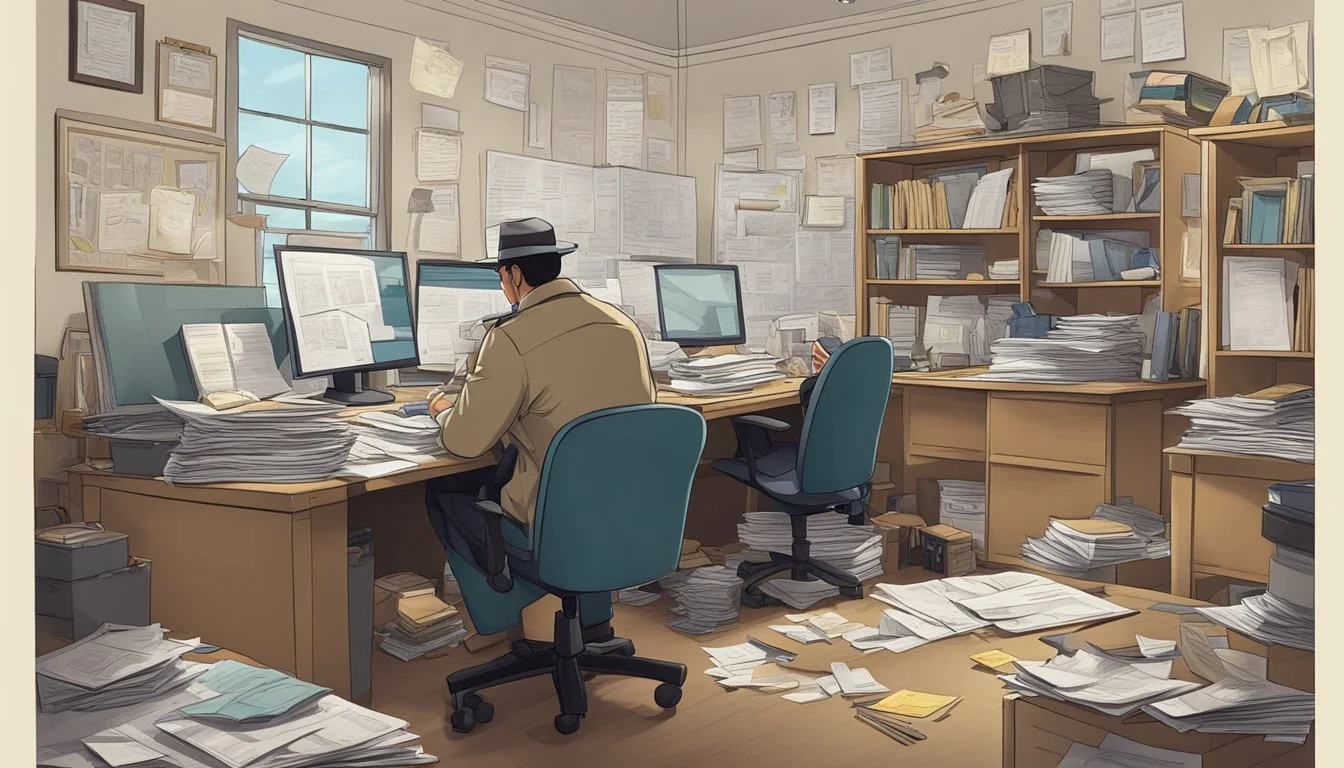Unraveling the Laci Peterson Mystery: New Documentary Exposes Shocking Truths Behind the Crime!
The disappearance and murder of Laci Peterson in 2002 captivated the nation, sparking intense media coverage and public interest. Her case remains one of the most notorious crimes in recent American history, with the conviction of her husband Scott Peterson continuing to generate debate and scrutiny.
Netflix's new documentary series "American Murder: Laci Peterson" revisits this tragic case, offering fresh perspectives and unprecedented access to key figures involved. The three-part series, directed by Skye Borgman, combines archival footage, courtroom recordings, and new interviews to provide a comprehensive look at the events surrounding Laci's disappearance and the subsequent investigation.
The documentary features interviews with Laci's mother, Sharon Rocha, as well as friends, detectives, and jurors from the trial. It examines the circumstantial evidence that led to Scott Peterson's conviction and explores the impact of media coverage on the case's outcome. By delving into this complex and emotionally charged story, the series aims to shed new light on a crime that continues to fascinate and disturb the public two decades later.
Background on Laci Peterson
Laci Peterson's life and tragic death captivated the nation in the early 2000s. Her disappearance while pregnant and subsequent murder became one of the most high-profile criminal cases of the decade.
Early Life and Relationship with Scott Peterson
Laci Denise Rocha was born on May 4, 1975, in Modesto, California. She grew up in a close-knit family and was known for her vibrant personality and warm smile. Laci met Scott Peterson while attending California Polytechnic State University in San Luis Obispo.
The couple began dating and eventually married in 1997. They settled in Modesto, where Laci worked as a substitute teacher. Friends and family described their relationship as seemingly happy and loving.
Scott and Laci opened a sports bar together called The Shack, which they ran for two years before selling it in 2000.
Pregnancy and Public Persona
In 2002, Laci became pregnant with the couple's first child, a boy they planned to name Conner. Her due date was February 10, 2003. Laci embraced her pregnancy, eagerly anticipating motherhood.
She was often seen walking the family's golden retriever in their neighborhood. Laci's bubbly personality and excitement about her pregnancy endeared her to many in the community.
On December 24, 2002, Laci, then eight months pregnant, was reported missing by her family. Her disappearance quickly gained national attention, with her husband Scott initially appearing distraught in public appeals for her safe return.
Disappearance and Discovery
Laci Peterson vanished on Christmas Eve 2002, sparking a massive search. Her disappearance gripped the nation for months until the tragic discovery of her remains in San Francisco Bay.
Christmas Eve 2002 Events
On December 24, 2002, Laci Peterson, eight months pregnant, was last seen alive at her home in Modesto, California. Her husband Scott reported her missing that evening when he returned from a fishing trip.
Neighbors recalled seeing Laci walk the family dog that morning. Her vehicle was found in the driveway, and her purse and keys were still in the house.
The timeline of events on Christmas Eve became crucial to the investigation. Police focused on Scott Peterson's movements and alibi for that day.
Initial Search Efforts
Law enforcement launched an extensive search operation immediately after Laci's disappearance was reported. Volunteers combed the area, and missing person flyers were distributed widely.
The case quickly gained national media attention. Search teams utilized helicopters, boats, and cadaver dogs to scour local parks, waterways, and rural areas.
Investigators interviewed neighbors, friends, and family members. They also examined surveillance footage from nearby businesses for potential leads.
As weeks passed without a trace of Laci, the search expanded to cover a wider geographic area.
Body Discovery in San Francisco Bay
On April 13, 2003, nearly four months after Laci's disappearance, a couple walking their dog discovered the remains of a late-term male fetus on the shore of San Francisco Bay.
The next day, a decomposed female body was found nearby. DNA testing confirmed the remains belonged to Laci Peterson and her unborn son, Conner.
The location of the bodies, about 90 miles from the Petersons' home, raised questions about how they ended up there. This discovery shifted the investigation from a missing person case to a homicide.
The condition of the remains provided crucial forensic evidence for the prosecution in the subsequent trial of Scott Peterson.
Investigation
The investigation into Laci Peterson's disappearance involved extensive police work and key witness testimony. Detectives pursued numerous leads and conducted thorough searches, while a critical eyewitness account emerged that would prove pivotal to the case.
Police Involvement and Detectives
Modesto Police Department took charge of the investigation immediately after Laci's disappearance was reported on December 24, 2002. Detective Al Brocchini led the initial inquiry, working closely with Detective Craig Grogan.
The police conducted extensive searches of the Peterson home and surrounding areas. They also examined Scott Peterson's alibi and movements on the day Laci vanished.
Investigators used cadaver dogs and sonar equipment to search waterways and fields. They followed up on hundreds of tips from the public, but many led to dead ends.
Amber Frey and Eyewitness Accounts
Amber Frey, Scott Peterson's mistress, became a key witness in the case. She contacted police after learning about Laci's disappearance and agreed to record her phone conversations with Scott.
These recordings revealed Scott's deceptive behavior and lack of concern for his missing wife. Frey's testimony and the recorded conversations became crucial evidence for the prosecution.
Eyewitness accounts played a significant role. Several neighbors reported seeing Laci walking her dog on the morning of December 24, contradicting Scott's timeline of events.
A neighbor also claimed to have seen Scott loading something heavy into his truck. These testimonies helped prosecutors build their case against Scott Peterson.
The Trial of Scott Peterson
The trial of Scott Peterson for the murder of his wife Laci and their unborn son Conner was a high-profile legal case that captivated the nation. It involved complex legal proceedings, controversial evidence, and ultimately resulted in Peterson's conviction and sentencing.
Legal Proceedings
The trial began on June 1, 2004, in Redwood City, California. Judge Alfred A. Delucchi presided over the case. The prosecution, led by Rick Distaso, argued that Peterson had killed his wife on December 24, 2002.
The defense team, headed by Mark Geragos, maintained Peterson's innocence. They proposed alternative theories and challenged the prosecution's evidence.
The trial lasted for five months, with intense media coverage throughout. It included testimony from 184 witnesses and the presentation of nearly 400 pieces of evidence.
Evidence and Witness Testimony
The prosecution's case relied heavily on circumstantial evidence. They presented Peterson's extramarital affair with Amber Frey as a motive for the murder.
Key evidence included:
GPS tracking data from Peterson's truck
Suspicious purchases, including a boat
Incriminating statements made by Peterson
The defense challenged the lack of direct evidence linking Peterson to the crime. They questioned the reliability of witness testimonies and proposed alternative suspects.
Forensic experts testified about DNA evidence found on items recovered from the crime scene and Peterson's boat.
Conviction and Sentencing
On November 12, 2004, the jury found Scott Peterson guilty of first-degree murder for killing Laci and second-degree murder for the death of their unborn son.
The penalty phase began on November 30, 2004. Prosecutors sought the death penalty, while the defense argued for life imprisonment.
On December 13, 2004, the jury recommended the death penalty. Judge Delucchi formally sentenced Peterson to death by lethal injection on March 16, 2005.
Peterson was sent to San Quentin State Prison to await execution. However, in 2020, the California Supreme Court overturned his death sentence due to jury selection issues. He was resentenced to life in prison without the possibility of parole in December 2021.
Media Coverage and Public Reception
The Laci Peterson case sparked intense media attention and profoundly impacted public perception. News outlets provided extensive coverage, while the public became deeply invested in the unfolding drama.
Press Involvement
Journalists flocked to Modesto, California, turning the disappearance of Laci Peterson into a national news story. Major networks aired daily updates, and local reporters camped outside the Peterson home. The case dominated headlines for months.
Media outlets scrutinized every detail, from Scott Peterson's behavior to police investigations. Press conferences became media events, with reporters clamoring for new information. Some critics argued the extensive coverage influenced the legal proceedings.
Impact on Public Perception
The media frenzy shaped public opinion about the case. Many viewers formed strong emotional connections to Laci Peterson and her unborn child. Television coverage often portrayed Scott Peterson in a negative light, fueling public suspicion.
Online forums and social media allowed people to discuss theories and share opinions. The case became a topic of heated debate across the country. Public interest remained high throughout the trial and continues today.
Documentaries like "The Murder of Laci Peterson" further examined the media's role in shaping perceptions. These programs offered new perspectives on the coverage and its lasting impact on public understanding of the case.
Documentary Analysis
Recent documentaries examining the Laci Peterson case provide in-depth looks at the investigation, trial, and aftermath. These series utilize interviews, archival footage, and expert analysis to shed new light on this high-profile murder.
Structure of the Documentary
Most Laci Peterson documentaries follow a chronological structure, starting with her disappearance on Christmas Eve 2002. They typically span 4-6 episodes, each focusing on a different aspect of the case. The series often begin with background on Laci and Scott's relationship before delving into the investigation.
Later episodes cover the trial, verdict, and Scott Peterson's time on death row. Some documentaries, like "The Murder of Laci Peterson," incorporate new evidence and theories that have emerged since the original trial.
Examination of Episodes and Content
Episodes frequently feature a mix of news footage, police interrogation videos, and courtroom scenes. Many documentaries include interviews with key figures such as investigators, attorneys, and family members. Some series, like those produced by Ross M. Dinerstein, use dramatic reenactments to visualize crucial moments in the case.
Expert commentary from forensic specialists, legal analysts, and criminologists is often woven throughout. These insights help contextualize evidence and explain the complexities of the investigation and trial.
Differing Perspectives and Interviews
Documentaries on the Laci Peterson case present various viewpoints to provide a balanced narrative. Interviews with prosecution team members highlight the evidence against Scott Peterson. Defense attorneys and Scott's supporters offer alternative theories and point out potential flaws in the investigation.
Some series, like those featuring Rebecca Evans' investigative work, include interviews with jurors, providing insight into their decision-making process. Family members from both sides share personal stories and emotional impacts. These diverse perspectives allow viewers to form their own opinions about the case's complexities.
Aftermath and Legacy
The Laci Peterson case continues to have far-reaching impacts years after the trial. Legal challenges and family advocacy efforts keep the story in the public eye.
Appeals and Claims of Innocence
Scott Peterson's legal team has filed multiple appeals since his conviction. In 2020, the California Supreme Court overturned his death sentence due to jury selection issues. The Los Angeles Innocence Project took on Peterson's case in 2023, investigating potential new evidence.
Peterson maintains his innocence. His supporters point to a lack of physical evidence linking him to the murders. Critics argue the circumstantial evidence is overwhelming. The burden of proof remains a key point of contention in ongoing legal battles.
Family Perspectives and Advocacy
Laci's mother, Sharon Rocha, continues to speak out about her daughter's murder. She has written books and given interviews sharing her family's perspective. Rocha advocates for victims' rights and domestic violence awareness.
Scott's sister-in-law, Janey Peterson, leads efforts to prove his innocence. She manages websites and social media accounts dedicated to the case. Janey Peterson has appeared in documentaries presenting alternative theories about Laci's disappearance.
The opposing viewpoints of the two families highlight the lasting divisions created by this high-profile case. Their continued advocacy ensures public interest remains high decades after the crime.
Documentary Production Insights
The production of Laci Peterson documentaries involved careful research, creative storytelling approaches, and input from key contributors. These projects aimed to shed new light on the high-profile case while navigating ethical considerations.
Key Contributors
Director Skye Borgman led Netflix's documentary on the Laci Peterson case. Her true crime expertise helped shape the narrative. Former ABC News producer Mike Gudgell provided valuable insights from his prior coverage.
Detective Al Brocchini, who worked on the original investigation, offered a law enforcement perspective. His participation added credibility to the documentary's claims.
Shareen Anderson directed "Face to Face with Scott Peterson" for Peacock. She secured the first on-camera prison interview with Peterson in decades.
Creative Approach and Challenges
The documentaries used a mix of archival footage, new interviews, and reenactments to tell the story. Producers faced the challenge of presenting fresh information on a widely-covered case.
Netflix's documentary received a TV-14 rating, balancing the need to convey key details without sensationalizing the tragedy. The creative team had to carefully consider how to depict sensitive topics.
Obtaining access to key figures posed a significant hurdle. Scott Peterson's prison interview was a major coup for the Peacock series, offering viewers unprecedented access to hear his side of the story.
Viewer Reception and Critique
Audiences praised the documentaries for providing new perspectives on the case. Many viewers appreciated the in-depth exploration of evidence and testimony.
Some critics argued that the projects risked re-traumatizing Laci Peterson's family. Others felt certain documentaries leaned too heavily on speculation.
The renewed interest generated by these films sparked public debates about the justice system and media coverage of high-profile cases. Viewer discussions on social media platforms demonstrated the lasting impact of the Laci Peterson story.
Comparing Cases and Documentary Interpretations
The Laci Peterson case has inspired numerous documentaries, each offering unique perspectives. These productions have shaped public understanding and influenced true crime media.
Similar Cases in Media
The Laci Peterson case shares similarities with other high-profile disappearances. Natalee Holloway's case garnered significant media attention, spawning multiple documentaries. Both cases involved young women who vanished under mysterious circumstances.
"Sophie: A Murder in West Cork" examines another complex case that captivated audiences. These documentaries often explore the investigation process, community impact, and legal proceedings.
Netflix and Peacock have produced competing documentaries on the Peterson case. Each offers a distinct interpretation of events, encouraging viewers to reconsider their understanding of the case.
Influence on True Crime Genre
The Peterson case documentaries have significantly impacted the true crime genre. They've set standards for in-depth exploration of evidence and witness testimonies.
"Face to Face with Scott Peterson" on Peacock provides a fresh perspective by featuring interviews with Peterson himself. This approach has inspired other documentaries to seek direct input from key figures.
These productions have raised the bar for true crime content. They employ advanced storytelling techniques, combining archival footage with expert analysis. This approach has become a template for examining complex criminal cases in media.







